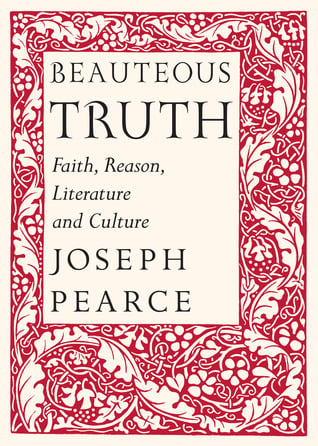This collection harkens back to a bygone era when the essay was a common medium of the literary artist. As one can pick up a volume of essays by G.K. Chesterton or Hilaire Belloc nearly a century after their first publication and still be enthralled and enchanted by their freshness and continuing relevance, the same may someday be said of Beauteous Truth, a compendium of literary essays by widely published Catholic author Joseph Pearce.
The volume is divided into five sections: Defining Our Terms, Celebrating Our Heritage, Literary Landscapes, Literary Portraits, and Self-Portraits. The first section’s title echoes a bit of advice Pearce received as a young man. While it strikes one as common sense, it is significant for the fact that, at the time it was uttered, Pearce was, in the words of Auberon Waugh, a “wretched youth” immersed in a world of racism and nonsense:
There was one older person in my youth whom I took seriously, largely, I’m sure, because his prejudices reflected mine. . . . He was something of a mentor and I remember he would often begin a discussion with an insistence that we define our terms. If we were discussing capitalism, or communism, or free trade, or the free market, or private property, he would always begin by asking me to define what I meant by these things. . . . Although I was sometimes irritated by this somewhat stolid approach to debate, I realize now that he was teaching me how to think. He was taking me, slowly but surely, from mere derivatives, such as politics and economics, to an appreciation of the important things, such as philosophy and, eventually, theology.
Belloc once observed that “all conflict is ultimately theological,” and nowhere do we see this more than in the battle for culture. As Pearce points out, this is a battle between “the healthy popular culture of the rooted common man” and “the inane pop culture of the rootless masses.” When the roots are cut, the organism experiences a slow decay, until the life-giving nourishment that was made possible only through those roots is spent. Pearce sharply critiques relativism, that philosophy which masks itself in tolerance but ruthlessly demands unquestioned obedience. Armed with both common sense and intellectual prowess, Pearce fights back with the tenacity of an English bulldog and with the charity of an English innkeeper. There is not a modern intellectual debate that he does not engage: historical realism versus historical relativism; science versus scientism; ethnomasochism; sex and culture.
In the middle sections, Pearce takes us on an excursion among the “communion of saints” that may be said to unite Englishmen:
From the anonymous author of Beowulf to the anonymous author of Sir Gawain and the Green Knight we have a heritage of several centuries of Catholic culture. Beowulf and Sir Gawain, and everything in between, are forged together by the faith that fathered them. We don’t know who wrote these works[,] and it doesn’t seem to matter. We don’t know their names[,] but we do know their Creed. They believe what we believe and are united with us in a union, and Communion, that is greater than time and space. A Catholic Englishman, alive today, has much more in common with the Anglo-Saxon author of “The Dream of the Rood” than he does with the vast bulk of those who happen, by a sheer accident of history, to be walking around at the same time and sharing the same time and place that used to be England. Time and space are but accidents; eternity is of the essence.
The great figures of the Catholic Literary Revival in English letters most significantly express this conviction through their art. Newman and Wilde, Chesterton and Belloc, Tolkien and Greene—in treating these noted authors, Pearce’s essays form a veritable theology of English literature. Some of these men were tortured souls, intellectually and morally; some lived rather happy lives, but lives nonetheless marked by sorrows. Of all the authors Pearce considers, the lesser-known Maurice Baring is probably the most eloquent on this latter point:
One has to accept sorrow for it to be of any healing power, and that is the most difficult thing in the world . . . A priest once said to me, “When you understand what accepted sorrow means, you will understand everything. It is the secret of life.”
Their art is a reflection of truth, goodness, and beauty, formed by deep convictions that were held until the “shipwreck” of the Reformation. Yet Pearce doesn’t hesitate to laud T.S. Eliot and C.S. Lewis, shipwreck survivors who sought truth from the heavens and who, in his view, very probably—had they lived longer—would have come back to theological civilization.
If there is one deficiency in this collection, it is that Pearce has not included more on Evelyn Waugh. While Pearce firmly places him among the great literary converts and leading figures of the Catholic Literary Revival, he spends little time on him. Nonetheless, this wonderful volume introduces readers to the glories of English literature as part of the larger culture of the West, while demonstrating that the art and lives of these literary masters may, if the reader allows, lead him to God.
[Beauteous Truth: Faith, Reason, Literature and Culture, by Joseph Pearce (South Bend, IN: St. Augustine’s Press) 280 pp., $30.00]

Leave a Reply